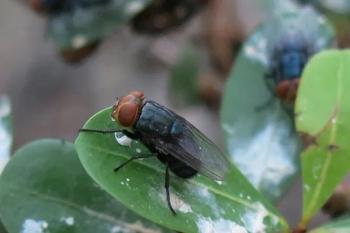
Diverse group of diseases culprits for feline eosinophilic granulomas
Most lesions wax and wane with or without therapy; so unpredictable ecurrence should be anticipated.
Q How does one manage eosinophilic granuloma complex in cats?
A Dr. Stephen D. White at the 28th World Congress of the World Small Animal Veterinary Association in Bangkok, Thailand, gave a lecture on eosinophilic granuloma complex in cats and dogs. Some relevant points in this lecture are provided below.
The eosinophilic granuloma complex in the cat actually results in inflammatory reactions of the skin and can be associated with hypersensitivity diseases. While this complex generally has been regarded as idiopathic, any underlying disease can result in the complex. A recent article suggests that Felis domesticus allergen I (Feld I) could be an autoallergen responsible for chronic inflammatory reactions in cats with the complex. Cat skin can respond with eosinophils to a diverse group of diseases, including allergies, pemphigus, neoplasia or pyoderma.
Lip ulcers
The lip ulcer (eosinophilic ulcer, indolent ulcer, rodent ulcer) is found usually on the upper lip of cats. Diagnosis is based on clinical appearance and histopathologic examination, which generally reveals hyperplastic ulcerative superficial perivascular dermatitis with eosinophils or neutrophils, mononuclear cells and fibrosis. Blood eosinophilia and tissue eosinophilia are less common than the other diseases in this complex. The primary underlying diseases identified with the indolent lip ulcer are flea allergy, food allergy and atopic dermatitis; when these are controlled, the lip lesion resolves.
Eosinophilic plaque
The eosinophilic plaque usually is seen on the ventral abdomen or inner thigh. Typical lesions show raised erythematous orange to yellow plaques. Biopsy reveals hyperplastic, superficial and deep perivascular dermatitis with eosinophilia, and at times a diffuse, eosinophilic dermatitis. Eosinophilic microvesicles and microabscesses might be seen in the epidermis. The eosinophilic plaque has been associated with the underlying diseases of food allergy, flea allergy and atopy.
Associated with mosquito bites
Feline eosinophilic granuloma occurs most commonly in the oral cavity or in a linear fashion on the back legs. A subset of this disease has been associated with mosquito bites and presents as nodules, with or without ulceration, on the face, ears and feet. This condition has also been seen on, or within, the chin of cats (feline chin edema) and affecting the foot pads. Typically, the lesions have a papular to nodular configuration and histopathologically show granulomatous dermatitis with multifocal areas of collagen coated with the released substances from degranulated eosinophils (formerly known as collagen degeneration). Eosinophils are common in the biopsies from the face or oral cavity, and there can be a peripheral eosinophilia, too. Eosinophilic granuloma of the hind legs has been associated with the underlying disease of flea allergy; it has also been seen with an apparently genetic predilection in a colony of specific pathogen-free cats. Affecting the foot pads can be associated with certain types of cat litter.
Histopathologic examination
Definitive diagnosis of the eosinophilic granuloma complex should be made on histopathologic examination. If a primary cause (allergy) can be determined and controlled, then lesions should resolve permanently unless the animal re-encounters the offending allergen. Most lesions wax and wane with or without therapy; so an unpredictable schedule of recurrence should be anticipated. Drug dosages should be tapered to the lowest possible level (or discontinued, if possible) once the lesions have resolved.
Treatment strategies
Traditionally, eosinophilic granuloma complex has been treated with intramuscular injections of methylprednisolone acetate (Depo-Medrol) at 4 mg/kg, given once every two weeks for three injections. More-frequent use of this protocol will lead to the development of diabetes mellitus in a high percentage of cats. If further corticosteroid treatment is needed, initially oral prednisolone at a dosage of 1 mg/kg q12h, dexamethasone at 0.1-0.2 mg/kg q24-72h, or triamcinolone at 0.1-0.2 mg/kg q24-72h may be used, then tapered to the lowest effective dosage.
In an attempt to avoid corticosteroids, the following treatments have been reported or used. In one study, four of four eosinophilic granulomas, but zero of two eosinophilic plaques were shown to respond to administration of essential fatty acids (DermCaps). Dosages approximated the manufacturer's guidelines. These are well-tolerated medications. Cyclosporine produced a good response to a dose of 25 mg per cat in six cases of eosinophilic plaque and three cases of oral eosinophilic granuloma in one report. In three cases of indolent lip ulcers, the response was less impressive.
Megestrol acetate at 2.5-5 mg every 2-7 days can be effective in rare cases and is not recommended because of the severity of possible side effects.
Griseofulvin is the preferred treatment for dermatophytes but has occasionally been used for its anti-inflammatory effects in skin diseases in cats. Its dosage for the feline eosinophilic granuloma complex is similar to its use in treating dermatophytes at 25 mg/kg twice daily with food. This dosage should be given for at least one month to judge efficacy. Chlorambucil (Leukeran) is an alkylating agent that alters DNA synthesis. Its mechanism of action in the treatment of the eosinophilic granuloma complex is not understood. It is given at a dosage of 0.1-0.2 mg/kg daily and often in conjunction corticosteroids. Daily treatment is continued for four weeks and then changed to alternate days; the lowest possible dosage should be used. Toxicity is uncommon but reversible bone-marrow suppression does occur, and cats on chlorambucil should be monitored with CBCs and platelet counts every two to four weeks. Vomiting, diarrhea and anorexia have also been seen, but tend to resolve when the medication is given on alternate days.
Canine eosinophilic granuloma is most commonly reported in Arctic dog breeds and most often is seen on the inner thighs or in the mouth. Erythematous to yellow raised nodules with papillated surfaces are typical. Pruritus is variable. Diagnosis is by histopathologic examination that shows eosinophils and granulomatous inflammation around eosinophilic debris-coated collagen. Treatment is with prednisone at 1 mg/kg q12h for one week, then tapering down during the course of four to six weeks. Occasionally, higher initial dosages are necessary.
Canine eosinophilic furunculosis probably is a related disease. It occurs in many dog breeds but typically is seen in long-nosed large breeds or curious small breeds (i.e., terriers) with potential access to wasps, bees, ants, spiders and other venomous insects. The disease can be very rapid in onset, leading to nasal/muzzle swelling, exudation and pain. Large, swollen, erythematous lesions on the muzzle are the most common lesions, but similar lesions may be seen on the head, around the eye and pinna in some dogs. Impression smears often will show eosinophils. While diagnosis usually is done on a clinical basis, histopathologic confirmation will show lesions similar to that of the canine eosinophilic granuloma, but with more eosinophilic infiltration into the epidermis and follicular wall, a furunculosis, and fewer areas of eosinophilic debris-coated collagen. Treatment is the same for the canine eosinophilic granuloma.
By Johnny D. Hoskins
DVM, Ph.D., Dipl. ACVIM
Dr. Hoskins is owner of DocuTech Services. He is a diplomate of the American College of Veterinary Internal Medicine with specialities in small animal pediatrics. He can be reached at (225) 955-3252, fax: (214) 242-2200, or e-mail:
Newsletter
From exam room tips to practice management insights, get trusted veterinary news delivered straight to your inbox—subscribe to dvm360.






